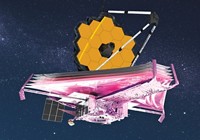Advertisement
Grab your lab coat. Let's get started
Welcome!
Welcome!
Create an account below to get 6 C&EN articles per month, receive newsletters and more - all free.
It seems this is your first time logging in online. Please enter the following information to continue.
As an ACS member you automatically get access to this site. All we need is few more details to create your reading experience.
Not you? Sign in with a different account.
Not you? Sign in with a different account.
ERROR 1
ERROR 1
ERROR 2
ERROR 2
ERROR 2
ERROR 2
ERROR 2
Password and Confirm password must match.
If you have an ACS member number, please enter it here so we can link this account to your membership. (optional)
ERROR 2
ACS values your privacy. By submitting your information, you are gaining access to C&EN and subscribing to our weekly newsletter. We use the information you provide to make your reading experience better, and we will never sell your data to third party members.
Astrochemistry
Astronomers find phosphorus at galaxy’s edge
Discovery hints at new chemistry, possibility for distant life
by Neil Savage, special to C&EN
November 10, 2023

Astronomers peering toward the outermost reaches of the Milky Way have found phosphorus, a critical element for life, where none was believed to exist (Nature, 2023, DOI: 10.1038/s41586-023-06616-1).
Using telescopes at the Arizona Radio Observatory and the Institute of Millimetric Radio Astronomy, a team from the University of Arizona (UA) detected signals emitted by electrons transitioning from one energy level to another in molecules of phosphorus monoxide and phosphorus mononitride. The signals came from a molecular cloud nearly 74,000 light years from the center of the galaxy. By comparison, Earth is about 26,000 light years from the center.
Phosphorus is believed to be created solely by supernovae, but in that part of the galaxy, matter is spread too thin to form stars big enough to create such massive explosions.
“There’s just no supernovae out in this part of the galaxy, so where’s the phosphorus coming from?” asks Lucy Ziurys, an astrochemist at UA, who led the study proposed by two of her graduate students.
Their observations suggest that lower mass stars may also produce phosphorus, which would help explain discrepancies in the amount of the element found in nearby regions of space. They also raise the possibility that habitable planets exist far beyond the area where astronomers have discovered them thus far. Biomolecules containing phosphorus, such as DNA, are more complex, but the discovery of simpler molecules mean that the element is available, raising the possibly that life could arise even at great distances from Earth.
“The galaxy’s a big place, and there might be nice, habitable solar systems at the edge, which people didn’t think would ever occur,” Ziurys says.




Join the conversation
Contact the reporter
Submit a Letter to the Editor for publication
Engage with us on Twitter